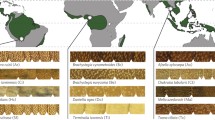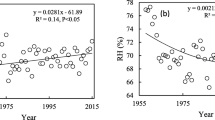Summary
Tree-ring data of naturally grown connifers were analyzed to evaluate the possibility of enhanced tree growth due to increased atmospheric CO2. Tree cores were obtained from 34 sites in four different climatic regions in the northern hemisphere. In each of the four regions, the sampling sites were located along ecological gradients between the subalpine treeline and low elevations and, sometimes, the arid forest border. Growth trends after 1950, when the atmospheric CO2 concentration increased by more than 30 μl·l-1 indicate an increase in ring-widths at eight of the 34 sites. These chronologies were from sites which moderate temperature or water stress. In four cases the growth increase in the post-1950 period coincided with favorable climatic conditions. In the remaining four cases, the growth increase exceeded the upper bound response expected from CO2 enrichment experiments with seedling conifer species. Therefore, increased growth in any of the tree-ring chronologies examined could not be solely attributed to higher atmospheric CO2 concentrations.
Similar content being viewed by others
References
Bacastow R, Keeling CD (1973) Atmospheric carbon dioxide and radiocarbon in the natural carbon cycle: Changes from AD 1700 to 2070 as deduced from a geochemical model. In: Woodwell GM, Pecan EV (eds) Carbon and the Biosphere. CONF-720510, Atomic Energy Commission, Washington DC, pp 86–117
Bannister B (1963) Dendrochronology. In: Bothwell D, Higgs E (eds) Science in archaeology. Basic Books, New York, pp 161–176
Blasing TJ, Solomon AM, Duvick DN (1984) Response functions revisited. Tree-Ring Bull 44:1–15
Bräker OU (1981) Der Alterstrend bei Jahrringdichten und Jahrringbreiten von Nadelhölzern und sein Ausgleich. Mitt Forstl Bundes-Versuchsanst Wien 142:75–102
Braun-Blanquet J (1964) Pflanzensoziologie. Grundzüge der Vegetationskunde. Springer, Wien New York
Brown K, Higginbotham KO (1986) Effects of carbon dioxide enrichment and nitrogen supply on growth of boreal tree seedlings. Tree Physiol 2:223–232
Bryan J, Wright R (1976) The effect of enhanced CO2 levels and variable light intensities on net photosynthesis in competing mountain trees. Am Mild Nat 95:446–450
Canham AE, McCavish WJ (1981) Some effects of CO2, daylength and nutrition on the growth of young forest tree plants. I. In the seedling stage. Forestry 54:169–182
Chang M, Lee R (1974) Objective double-mass analysis. Water Resour Res 10:1123–1126
Conroy JP, Smillie RM, Küppers M, Bevege DI, Barlow EW (1986) Chlorophyll A fluorescence and photosynthetic and growth responses of Pinus radiata to phosphorus deficiency, drought stress, and high CO2. Plant Physiol 81:423–429
Cook ER, Holmes RL (1985) Users' manual for program ARSTAN. Unpubl manuscript Lamont-Doherty Geological Observatory of Columbia University, Palisades, NY 10964
Cooper CF (1986) Carbon dioxide enhancement of tree growth at high elevations. Science 231:859
Cypruś Meteorological Office (1900–1974) Meteorological observations. Nicosia, Cyprus
Doyle TW (1987) Seedling response to CO2 enrichment under stressed and non-stressed conditions. In: Jacoby GC jr, Hornbeck JW (eds) Proc Int Symp on Ecological Aspects of Tree-Ring Analysis, 17–21 Aug 1986, Palisades NY. US Dept of Energy Conference Report CONF-8608144, pp 501–510
Eckstein D, Bauch J (1969) Beitrag zur Rationalisierung eines dendrochronologischen Verfahrens und zur Analyse seiner Aussagesicherheit. Forstwiss Centralbl 88:230–250
Eckstein D, Breyne A, Aniol RW, Liese W (1981) Dendroklimatologische Untersuchungen zur Entwicklung von Straßenbäumen. Forstwiss Centralbl 100:381–396
Ellenberg H, Klötzli F (1972) Waldgesellschaften und Waldstandorte der Schweiz. Eidg Anst forstl Versuchswes Mitt 48:589–930
Eriksson H (1984) Granens produktion i sodra Sverige-trender och fragetecken. In: Ekologisk stabilitet och skogsproduktion. Swed Univ Agric Sci, Skogsfakta Suppl No 3, pp 26–37
Fritts HC (1976) Tree rings and climate. Academic Press, London
Fritts HC, Blasing TJ, Hayden BP, Kutzbach JE (1971) Multivariate techniques for specifying tree-growth and climate relationships and for reconstructing anomalies in paleoclimate. J Appl Meterol 10:845–864
Gammon RH, Sundquist ET, Fraser PJ (1985) History of carbon dioxide in the atmosphere. In: Trabalka JR (ed) Atmospheric carbon dioxide and the global carbon cycle. US Department of Energy Report DOE/ER-0239, Washington, pp 27–62
Gates DM (1985) Global biospheric response to increasing atmospheric carbon dioxide concentration. In: Strain BR, Cure JD (eds) Direct effects of increasing carbon dioxide on vegetation. US Department of Energy Report DOE/ER-0238, Washington, pp 171–184
Gholz H, Grier CC, Campbell AG, Brown AJ (1979) Equations for estimating biomass and leaf area of plants in the Pacific Northwest. For Res Lab Res Pap 41. Corvallis, OR
Gifford RM (1985) Carbon dioxide stimulated growth and storage by terrestrial vegetation. In: Keir RS, Berger WH (eds) Carbon Dioxide Transfer in the Atmosphere. Ocean-Terrestrial System. Report SIO 85-31, Scripps Institute of Oceanography, San Diego, CA, pp 85–88
Graybill DA (1987) A network of high elevation conifers in the western US for detection of tree-ring growth response to increasing atmospheric carbon dioxide. In: Jacoby GC Jr, Hornbeck JW (eds) Proc Int Symp on Ecological Aspects of Tree-Ring Analysis. 17–21 Aug 1986. Palisades, NY. US Dept of Energy Conference Report CONF-8608144, pp 463–474
Green K, Wright R (1977) Field response of photosynthesis to CO2 enhancement in ponderosa pine. Ecology 58:687–692
Hansen J, Johnson D, Lacis A, Lebedeff S, Lee P, Rind D, Russell G (1981) Climatic impact of increasing atmospheric carbon dioxide. Science 213:957–966
Hari P, Arovaara H, Raunemaa T, Hautojarvi A (1984) Forest growth and the effects of energy production: A method for detecting trends in the growth potential of trees. Can J For Res 14:437–440
Jacoby GC (1986) Long-term temperature trends and a positive departure from the climate-growth response since the 1950s in high elevation lodgepole pine from California. In: Rosenzweig C, Dickinson R (eds) Proc of the NASA Conference on Climate-Vegetation Interactions, Greenbelt, Maryland, Jan 27–29, 1986. Office for Interdisciplinary Earth Studies (OIES), University Corporation for Atmospheric Research (UCAR), Boulder, Colorado. Report OIES-2, pp 81–83
Johnson DW, West DC, Todd DE, Mann LK (1982) Effects of sawlog vs whole-tree harvesting on the nitrogen, phosphorus, potassium and calcium budgets of an upland mixed oak forest. Soil Sci Soc Am J 46:1304–1309
Kienast F (1982) Jahrringanalytische Untersuchungen in immissionsgefährdeten Waldschadengebieten des Walliser Rhonetales. Geogr Helv 37:143–148
Kienast F, Schweingruber FH, Bräker OU, Schär E (1987) Treering studies on conifers along ecological gradients and the potential of single-year analyses. Can J For Res 17:683–696
Kohler MA (1949) On the use of double-mass analysis for testing the consistency of meteorological records and for making required adjustments. Bull Am Meteorol Soc 30:188–189
Kramer PJ (1981) Carbon dioxide concentration, photosynthesis, and dry matter production. BioScience 31:29–33
LaMarche VC Jr (1974a) Paleoclimatic inferences from long treering records. Science 183:1043–1048
LaMarche VC Jr (1974b) Frequency-dependent relationships between tree-ring series along an ecological gradient and some dendroclimatic implications. Tree-Ring Bull. 34:1–20
LaMarche VC Jr (1978) Tree-ring evidence of past climatic variability. Nature 276:334–338
LaMarche VC Jr, Graybill DA, Fritts HC, Rose MR (1984) Increasing atmospheric carbon dioxide: tree-ring evidence for growth enhancement in natural vegetation. Science 225:1019–1021
Larson PR (1963) Stem form development in forest trees. Forest Sci Monogr 5:1–42
Lenz O, Schär E, Schweingruber FH (1976) Methodische Probleme bei der radiographisch-densitometrischen Bestimmung der Dichte und der Jahrringbreiten von Holz. Holzforschung 30:114–123
Luxmoore RJ, O'Neill EG, Ells JM, Rogers HH (1986) Nutrient uptake and growth responses of Virginia Pine to elevated atmospheric carbon dioxide. J Environ Qual 15:244–251
MacLean CD, Berger JM (1976) Softwood tree volume equations for major California species. Res Note PNW-266. Portland, OR, US Department of Agriculture, Forest Service, Pacific Northewest Forest and Range Experiment Station
McGinnigle JB (1971) The climate at the summit of Mount Olympus Cyprus, unpubl manuscript. London Weather Centre, Meteorological Office
McGinnigle JB (1972) 10 years of weather observations from Mount Olympus, Cyprus. Meteorol Mag 101:39–43
Mountain Research Station Climate Program (1952–1982) Monthly temperature and precipitation data for D-1 (Niwot Ridge) and C-1 (Como). Data on tape. Institute of Arctic and Alpine Research, University of Colorado, Boulder
National Oceanic and Atmospheric Administration (NOAA), US Department of Commerce (USDC) (1981–1982) Montly climatic data for the world. Asheville, NC
Neumann M, Schieler K (1981) Vergleich spezieller Methoden zuwachskundlicher Schadensabschätzung. Mitt forstl Bundes-Versuchsanst Wien 139:49–65
Pollanschütz J (1971) Die ertragskundlichen Meßmethoden zur Erkennung und Beurteilung von forstlichen Rauchschäden. Mitt forstl Bundes-Versuchsanst Wien 92:153–206
Purohit AN, Tregunna EB (1976) Effects of carbon dioxide on the growth of Douglas-fir seedlings. Ind J Plant Physiol 19:164–170
Reynolds JF, Acock B (1985) Modeling approaches for evaluating vegetation responses to carbon dioxide concentration. In: Strain BR, Cure JD (eds) Direct Effects of Increasing Carbon Dioxide on Vegetation. US Department of Energy Report DOE/ER-0238, pp 33–51
Rudloff W (1981) World-Climates. Wissenschaftliche Verlagsgesellschaft, Stuttgart
Schulman E (1956) Dendroclimatic changes in semiarid America. University of Arizona Press, Tucson
Schweingruber FH (1983) Der Jahrring. Standort, Methodik, Zeit und Klima in der Dendrochronologie. Haupt, Bern
Schweingruber FH, Bräker OU, Schär E (1979) Dendroclimatic studies on conifers from Central Europe and Great Britain. Boreas 8:427–452
Sionit N, Strain BR, Hellmers H, Riechers GH, Jaeger CH (1985) Long-term atmospheric CO2 enrichment affects the growth and development of Liquidambar styraciflua and Pinus taeda seedlings. Can J For Res 15:468–471
Stockton CW (1984) An alternative hypothesis to direct CO2 fertilization as a cause of increased tree growth during 1850–1980 in Central Nevada. Preliminary Report, Laboratory of Tree-Ring Research, University of Arizona
Surano KA, Daley PF, Houpis JLJ, Shinn JH, Helms JA, Palasson RJ, Costella MP (1986) Growth and physiological responses of Pinus ponderosa to long-term elevated CO2 concentrations. Tree Physiol 2:243–259
Swiss Meteorological Institute (1874–1900) Annals. Monthly temperature and precipitation data. Zürich, Switzerland
Swiss Meteorological Institute (1982) Daily temperature and precipitation data. Data on tape. Zürich, Switzerland
Telewski FW, Strain BR (1987) Densitometric and ring width analysis of 3-year-old Pinus taeda L. and Liquidambar styraciflua L. grown under three levels of CO2 and two water regimes. In: Jacoby GC jr, Hornbeck JW (eds) Proc Int Symp on Ecological Aspects of Tree-Ring Analysis. 17–21 Aug 1986, Palisades, NY. US Dept of Energy Conference Report CONF-8608144
Tinus RW (1972) CO2 enriched atmosphere speeds growth of Ponderosa pine and blue spruce seedlings. Tree planters' notes 23:12–15
Thornley JHM (1976) Mathematical models in plant physiology: a quantitative approach to problems in plant and crop physiology. Academic Press, New York
Tolley LC, Strain BR (1984) Effects of CO2 enrichment on growth of Liquidambar styraciflua and Pinus taeda seedlings under different irradiance levels. Can J Forest Res 14:343–350
US Department of Agriculture (USDA) (1931) Summary of the climatological data for the US by sections (until 1930). Washington, DC
US Department of Commerce (USDC) (1931–1980) World weather records (each covering a 10-y period from 1921 through 1980). Washington, DC
Waring RH, Pitman GB (1985) Modifying lodgepole pine stands to change susceptibility to mountain pine beetle attack. Ecology 66:889–897
Wigley TML, Angell JK, Jones PD (1985) Analysis of the temperature record. In: MacGracken MC, Luther FM (eds) Detecting the climatic effects of increasing carbon dioxide. US Dept of Energy Report DOE/ER-0235, pp 55–90
Wright RD (1974) Rising atmospheric CO2 and photosynthesis of San Bernardino mountain plants. Am Midl Nat 91:360–370
Author information
Authors and Affiliations
Additional information
Major financial supporters: Swiss National Science Foundation (application no. 1.869-0.83); Swiss Federal Institute of Forestry Research, 8903 Birmensdorf, Switzerland; other financial supporters: Carbon Dioxide Research Division, U.S. Department of Energy under subcontract no. 11X-57507V with Martin Marietta Energy Systems, Inc
Operated by Martin Marietta Energy Systems, Inc., under contract DE-AC05-840R21400 with U.S. Department of Energy
Rights and permissions
About this article
Cite this article
Kienast, F., Luxmoore, R.J. Tree-ring analysis and conifer growth responses to increased atmospheric CO2 levels. Oecologia 76, 487–495 (1988). https://doi.org/10.1007/BF00397859
Received:
Issue Date:
DOI: https://doi.org/10.1007/BF00397859




